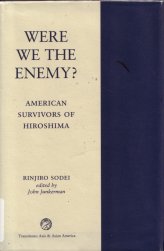
Were We The Enemy?: American Survivors of Hiroshima

Rinjiro Sodei, 1998.
The author starts off stating that the number of deaths in Hiroshima and Nagasaki were really about double what is normally reported; he holds that about 140,000 died in Hiroshima and 70,000 in Nagasaki.
The term "hibakusha" refers to a victim of one of the atomic bombs.
Some of the people killed were Japanese Americans who were unable to return to the U.S. once Japan bombed Pearl Harbor. The author also talks about some of the longer-range effects of the bomb on people who were in the areas where they were dropped.
There were around 3,000 Japanese-Americans living in Hiroshima when the bomb was dropped. Personal accounts of some of the survivors are then given. The reason there were so many of them there was that many had originally immigrated to the U.S. from the prefecture (state) where Hiroshima is located and, for one reason or another, some had returned to the city with family. Some were very young and had no choice in the matter; some were visiting sick relatives, others had other reasons but all were trapped there when the war started.
The author goes into a more detailed summary of Japanese immigration to the U.S., the various political aspects and the banning of further immigration, etc.
Next up is a discussion of the evacuation and internment camps. The real young Nisei were basically acculturated back into the Japanese fold; the teenage Nisei were accepted at first, but as the fortunes of war turned against Japan they felt they were sometimes considered spies working for the U.S. and some felt they had to prove their loyalty to Japan, much as the Japanese-Americans being evacuated felt they had to prove their loyalty to the U.S.
Hiroshima had gone almost totally unbombed during the war. Some Nisei women were basically drafted to translate intercepted shortwave messages (in the same manner as Nisei in the U.S. were translating intercepted Japanese transmissions.)
One of the reasons Hiroshima had not been the target of incendiary raids was that there were seven rivers flowing through the city, and this would have decreased the effectiveness of such an attack. Another reason why it was chosen as a target for the atomic bomb was that it was surrounded by hills that the military figured would increase the effectiveness of the bomb.
Kyoto was initially the first choice, and Kokura and Niigata were also considered along with Hiroshima. Political pressure and military preference resulted in Hiroshima being moved to the number one target, Niigata being dropped and Nagasaki being added as a possible target.
The author talks about some of the specific damage to Hiroshima and then discusses how the Japanese-Americans who had relatives there reacted when they heard the news of the bombing.
There was an effort by the U.S. to deny anyone was dying from radiation sickness, claiming the bomb was dropped at an altitude that would have cut down the amount of radiation hitting the ground. Follow-up studies on the city is the next thing discussed.
The author then talks about the occupation of Japan and how some Nisei had renounced their U.S. citizenship and returned to live in Japan.
One estimate is that there were 15,000 Nisei living in Japan at the end of the war. Then he discusses the issue of Nisei returning to the U.S. and which of them would actually be allowed to return. Then the author discusses how the Nisei managed to adjust after their return. The book then goes into the hibakusha in the U.S. in detail.
A lot of the material deals with the hibakusha trying to get proper medical attention. Various efforts to "study" the hibakusha met with a lack of success in Hawaii but greater success on the continental U.S.
More individual stories are then discussed, along with further efforts by the hibakusha to get some help from Congress.
This is a very specialized book and is only a little material relating to the internment process, but it's still an interesting work.
Main Index
Japan main page
Japanese-American Internment Camps index page
Japan and World War II index page
|